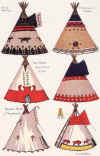By Ernest Thompson Seton

Fig 83.
The most conspicuous effort at painting that the Indian attempts-- and perhaps his most characteristic--is the decoration of the tepee. It certainly adds more to the picturesqueness of the camp than any other painting that the ordinary camper can master.
Having constructed the tepee according to the directions in the previous chapter, it is ready for the painting. This is most easily done as the cover lies flat on the ground or floor.
The following paints I have found most useful:
Red. Red lead is the only beautiful red that will stand the weather. Also, it is inexpensive.
Blue, cobalt or ultramarine, lightened with white lead. These are beautiful blues, but no blue will stand the sun indefinitely; all fade in time.
Medium chrome yellow, burnt umber, chrome green, lamp black, and white lead complete the list. All of these, except the last, I prefer to have as dry powder, to be mixed as I need them with raw linseed oil and a little Japan dryer. Often a little kerosene is used with the oil, to thin the colors and reduce the expense.
Some like to keep the canvas of the tepee pure white as a background, on account of its beauty in the landscape and its lightness inside. Some prefer khaki. I have seen a beautiful tepee made by dipping the whole thing in red dye before it was painted with the designs. The fact that the dye takes unevenly only adds to the good effect.
To paint it, lay the cover flat on the floor--all the better if tacked down; find the exact point around which the half circle was drawn in making it. With a string held at this point, and a chalk at the proper distance, trace all the semicircles that are indicated, or are needed for guidance. Chalk is best for this, as it is easily washed off later--one shower of rain and it is gone.
With these semicircles as guides, now sketch in the animals, etc.
Two sizes of brush are needed-one about 2 inches wide for large areas; and one 1/4 inch wide for stripes, etc. When changing from one color to another, brushes should be washed clean with kerosene, turpentine, or hot soapy water.
The tepees in Fig. 83 are shown without smoke poles, pegs, etc., for the sake of simplicity.
In the first example, the Sioux tepee, most of the pattern is black on the buff ground of the leather. The star is blue, and each of the four wolves is black with red ankles, kidneys, and heart; also red and blue bands on tail and on the life-line that goes down the throat. The black decoration at the bottom is supposed to be alternated trees and distant mountains. The light spots below are lakes, and may be buff or blue. On the smoke flaps are stars; these also may be buff or blue.
The second tepee was recorded by F. A. Verner of Toronto, Canada. It had a green chevron on the lower part. I do not know how authentic this was. The old Indians had neither green nor blue; and the best looking tepees I have seen were painted in red, black, yellow, and white.
Paul Kane gives a sketch of a Red Bear tepee as shown. The only colors are the red band, out of which the red bear comes; and the buff color of the leather.
On the lowest and last tepee, the animals were flat brown tint; the line on which they stand with the medicine ladder, blue.
Thunder Bull's tepee, I bought from him some twenty-five years ago in Oklahoma. It was not painted, but decorated with beaded shields, from each of which hung three tassels of grass and horsehair. The four shields on the side were about six inches across; the big one up near the lifting strap was twelve inches wide.
This tepee was part of my Indian Village at Cos Cob in 1902. I lived in it off and on for years--till it rotted away and was replaced by those now in use.